Inferring the 3D shape of objects shown in images is usually an easy task for a human. To solve it, our visual system simultaneously exploits a variety of monocular depth cues, such as lighting, shading, the relative size of objects or perspective effects. Perceiving the real world with two eyes even allows us to take advantage of another valuable depth cue, the so called binocular parallax. Because of the slightly different viewing position, the images projected to the retinas of both eyes will be slightly different. While objects close to the observer undergo a large displacement between the images, objects that are far away exhibit a small displacement. Because nearly all this happens unconsciously, we usually do not realize how tough this problem really is.
Combining Shape from Shading and Stereo


